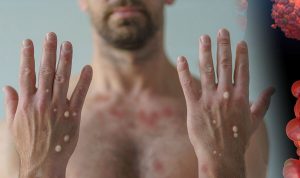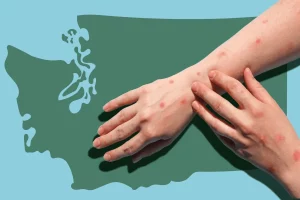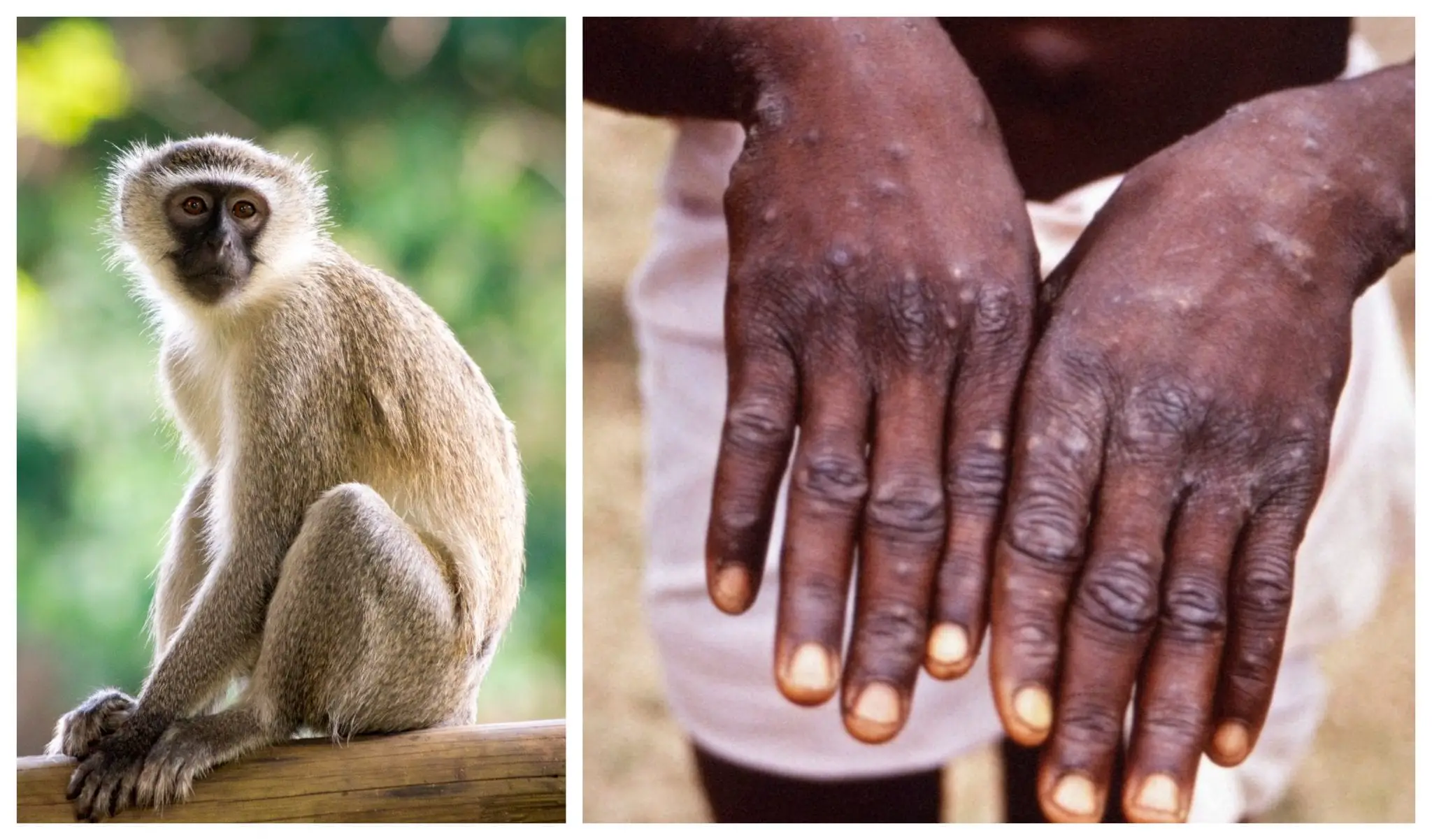Introduction
What is Monkeypox? Monkeypox is a zoonotic disease, meaning it primarily infects animals but can be transmitted to humans. The virus belongs to the same family as smallpox but is less severe. It was first discovered in 1958 in monkeys and later identified in humans in Central and West Africa.
Origin and Transmission The virus is typically transmitted to humans through direct contact with infected animals, such as rodents or primates, or through consumption of contaminated animal products. Human-to-human transmission can also occur, primarily through respiratory droplets or contact with skin lesions of an infected person.
Symptoms of Monkeypox
Early Symptoms
- Fever
- Headache
- Muscle aches
- Fatigue
Advanced Symptoms
- Distinctive rash
- Fluid-filled lesions
- Lesions crust over and scab
- Possible complications like pneumonia or encephalitis

Prevention Methods
Vaccination Currently, there is no specific treatment for Monkeypox, but vaccination can provide immunity against the virus. The smallpox vaccine has shown efficacy in preventing Monkeypox and is recommended for individuals at high risk of exposure, such as healthcare workers and laboratory personnel.
Hygiene Practices Practicing good hygiene habits, such as frequent handwashing with soap and water, can help prevent the spread of Monkeypox. Avoiding contact with wild animals and their products, particularly in regions where Monkeypox is endemic, is also essential.
Keeping Kids Safe
Importance of Awareness Parents play a crucial role in educating their children about Monkeypox and instilling preventive measures. By raising awareness and promoting healthy habits, families can reduce the risk of infection among children.
Specific Measures for Children When outbreaks occur, parents should closely monitor their children for any symptoms of Monkeypox and seek medical attention promptly if they suspect exposure. Encouraging children to avoid contact with sick individuals and practice proper hygiene can minimize the risk of transmission.

What Parents Should Look Out For
Signs of Monkeypox in Children Parents should be vigilant for symptoms such as fever, rash, and swollen lymph nodes in their children, especially if they have been in contact with wild animals or individuals with confirmed Monkeypox.
When to Seek Medical Help If a child exhibits symptoms consistent with Monkeypox or has been exposed to the virus, it’s essential to consult a healthcare professional for evaluation and testing. Early detection and intervention can prevent complications and facilitate timely treatment.
Educating Children About Monkeypox
Age-Appropriate Information When discussing Monkeypox with children, it’s important to provide age-appropriate information that is accurate but not overly alarming. Emphasizing simple preventive measures, such as handwashing and avoiding contact with sick individuals, can empower children to protect themselves.
Teaching Hygiene Habits Parents can reinforce good hygiene habits by leading by example and incorporating handwashing into daily routines. Teaching children proper handwashing techniques and explaining the importance of cleanliness can reduce the risk of infection.
Debunking Myths and Misconceptions
Common Misconceptions About Monkeypox Misinformation about Monkeypox can lead to unnecessary fear and stigma. Addressing common myths, such as the belief that the virus only affects monkeys or that it is invariably fatal, can help dispel misconceptions and promote understanding.
Facts vs. Fiction Providing accurate information about the transmission, symptoms, and prevention of Monkeypox can empower parents to make informed decisions about their children’s health. Encouraging dialogue and addressing concerns openly can foster trust and cooperation within communities.
The Role of Schools and Communities
School Policies and Protocols Schools can implement policies and protocols to prevent the spread of infectious diseases, including Monkeypox. Educating staff, students, and parents about hygiene practices and vaccination recommendations can promote a safe learning environment.
Community Support and Education Initiatives Community-based initiatives, such as public health campaigns and outreach programs, can raise awareness about Monkeypox and promote preventive measures. Collaboration between healthcare providers, schools, and community organizations is essential for effective communication and coordination.

Handling Suspected Cases
Isolation Procedures In the event of a suspected Monkeypox case, prompt isolation of the affected individual is crucial to prevent further transmission. Healthcare facilities should follow established protocols for infection control and contact tracing to contain the spread of the virus.
Contact Tracing Identifying and monitoring individuals who have been in close contact with confirmed cases can help prevent secondary transmission of Monkeypox. Contact tracing efforts should be thorough and coordinated to ensure timely intervention and containment.
Staying Calm and Informed
Reliable Sources of Information In the age of social media and instant communication, it’s essential to rely on credible sources of information for updates on Monkeypox and other health-related concerns. Government agencies and reputable healthcare organizations provide accurate and timely guidance to the public.
Avoiding Panic While Monkeypox outbreaks can be concerning, it’s important to avoid panic and misinformation. Staying informed, following recommended precautions, and seeking guidance from healthcare professionals can help alleviate anxiety and promote resilience within communities. Explore More About (Heart Health)
Monkeypox and the COVID-19 Pandemic
Overlapping Concerns The emergence of Monkeypox outbreaks amidst the COVID-19 pandemic presents unique challenges for public health authorities and communities. Coordinating response efforts and addressing dual health threats require careful planning and collaboration at local, national, and global levels.
Managing Dual Health Threats Efforts to control Monkeypox must complement existing measures for COVID-19 prevention and control. Maintaining surveillance systems, ensuring access to healthcare services, and promoting vaccination uptake are essential strategies for mitigating the impact of both diseases.
| Aspect | Smallpox | Monkeypox |
|---|---|---|
| Causative Agent | Variola virus | Monkeypox virus |
| Origin | Likely originated in Africa | Discovered in laboratory monkeys in 1958, primarily found in Central and West Africa |
| Transmission | Human-to-human contact, respiratory droplets, contaminated objects | Similar to smallpox; human-to-human transmission, contact with infected animals |
| Incubation Period | Around 12 to 14 days | 5 to 21 days |
| Initial Symptoms | Fever, malaise, headache, severe backache, rash | Fever, headache, muscle aches, fatigue |
| Rash | Starts on face and extremities, spreads to trunk; progresses from macules to papules to pustules | Begins on face and spreads to other parts of the body; evolves into raised bumps filled with fluid |
| Mortality Rate | Historically high, up to 30% | Lower than smallpox, typically less severe; mortality rate varies |
| Vaccination | Smallpox vaccine available, eradicated globally | No specific vaccine for monkeypox; smallpox vaccination may provide some cross-protection |
| Global Eradication | Eradicated in 1980 | Cases still reported, primarily in Central and West Africa |
| Prevention | Vaccination, isolation of cases, contact tracing | Hand hygiene, avoiding contact with wild animals, respiratory hygiene |
Global Efforts and Research
Current Research on Monkeypox Ongoing research aims to enhance understanding of Monkeypox epidemiology, transmission dynamics, and potential interventions. Collaborative studies involving researchers, policymakers, and healthcare professionals contribute to evidence-based strategies for disease control and prevention.
International Collaboration Given the global nature of infectious diseases, international collaboration is essential for addressing Monkeypox and other emerging health threats. Sharing data, resources, and expertise facilitates coordinated response efforts and strengthens preparedness for future outbreaks.
Conclusion
In conclusion, staying informed and taking proactive measures are key to keeping children safe from Monkeypox. By promoting awareness, practicing good hygiene, and collaborating with schools and communities, parents can reduce the risk of infection and ensure the health and well




